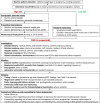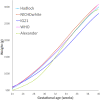FIGO (international Federation of Gynecology and obstetrics) initiative on fetal growth: best practice advice for screening, diagnosis, and management of fetal growth restriction
- PMID: 33740264
- PMCID: PMC8252743
- DOI: 10.1002/ijgo.13522
FIGO (international Federation of Gynecology and obstetrics) initiative on fetal growth: best practice advice for screening, diagnosis, and management of fetal growth restriction
Abstract
Fetal growth restriction (FGR) is defined as the failure of the fetus to meet its growth potential due to a pathological factor, most commonly placental dysfunction. Worldwide, FGR is a leading cause of stillbirth, neonatal mortality, and short- and long-term morbidity. Ongoing advances in clinical care, especially in definitions, diagnosis, and management of FGR, require efforts to effectively translate these changes to the wide range of obstetric care providers. This article highlights agreements based on current research in the diagnosis and management of FGR, and the areas that need more research to provide further clarification of recommendations. The purpose of this article is to provide a comprehensive summary of available evidence along with practical recommendations concerning the care of pregnancies at risk of or complicated by FGR, with the overall goal to decrease the risk of stillbirth and neonatal mortality and morbidity associated with this condition. To achieve these goals, FIGO (the International Federation of Gynecology and Obstetrics) brought together international experts to review and summarize current knowledge of FGR. This summary is directed at multiple stakeholders, including healthcare providers, healthcare delivery organizations and providers, FIGO member societies, and professional organizations. Recognizing the variation in the resources and expertise available for the management of FGR in different countries or regions, this article attempts to take into consideration the unique aspects of antenatal care in low-resource settings (labelled “LRS” in the recommendations). This was achieved by collaboration with authors and FIGO member societies from low-resource settings such as India, Sub-Saharan Africa, the Middle East, and Latin America.
Keywords: FIGO initiative; Fetal growth restriction; detection; diagnosis; management; monitoring.
Figures






References
-
- Gordijn SJ, Beune IM, Thilaganathan B, et al. Consensus definition of fetal growth restriction: a Delphi procedure. Ultrasound Obstet Gynecol. 2016;48(3):333‐339. - PubMed
-
- Hadlock FP, Harrist RB, Sharman RS, Deter RL, Park SK. Estimation of fetal weight with the use of head, body, and femur measurements–a prospective study. Am J Obstet Gynecol. 1985;151(3):333‐337. - PubMed
-
- Sheiner E, Kapur A, Retnakaran R, et al. FIGO (International Federation of Gynecology and Obstetrics) postpregnancy initiative: long‐term maternal implications of pregnancy complications‐follow‐up considerations. Int J Gynecol Obstet. 2019;147(Suppl 1):1‐31. - PubMed
Publication types
MeSH terms
LinkOut - more resources
Full Text Sources
Other Literature Sources
Medical
Miscellaneous

